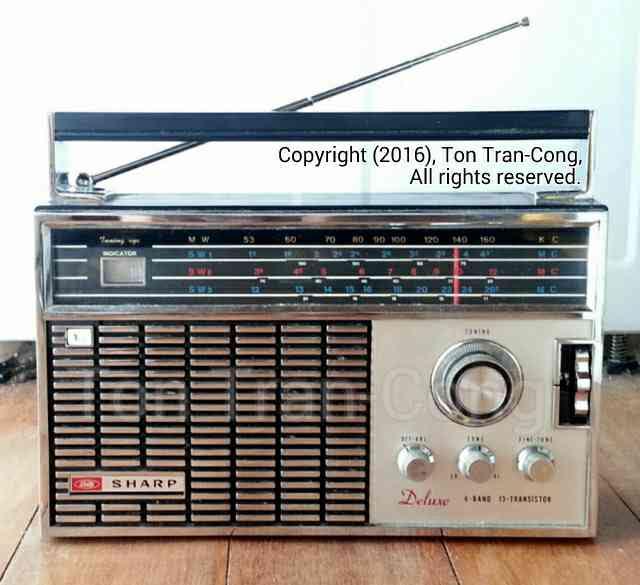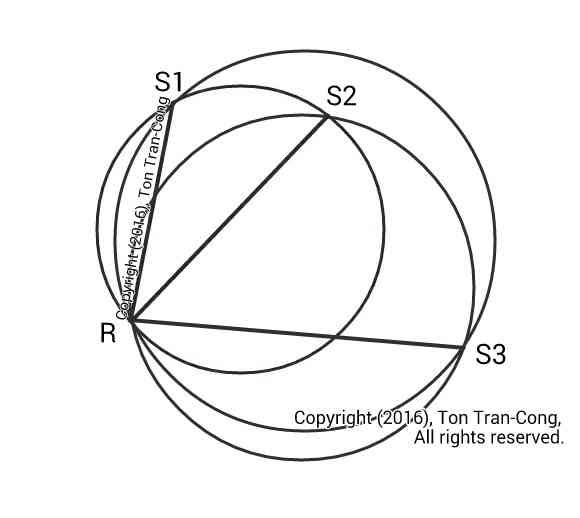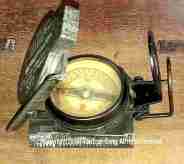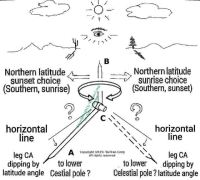Navigating with an AM MW radio receiver
by tonytran2015 (Melbourne, Australia).
Click here for a full, up to date ORIGINAL ARTICLE and to help fighting the stealing of readers’ traffic.
(Blog No.48).
#AM, #broadcast, #emergency, #radio, #radio direction finding, #find North, #Medium Wave, #radio navigation.
Every natural disaster emergency kit is recommended by authorities to include a battery operated Amplitude Modulation Medium Wave (AM MW, also called AM Broadcast) radio receiver to receive critical information and instructions.
The radio receiver can actually do much more than receiving information and instructions. It can find the direction to nearby AM broadcasting stations and even find your location on any map showing the stations.

Figure: Map of Melbourne with 2 nearby AM broadcasting stations shown as red dots. Map has been modified from original map used under Open License from Open Street Map, the data are owned by Open Street Map Contributors.
The technique is applicable when there are nearby (closer than 100km) AM broadcast stations. It is useful to regions near the terrestrial magnetic poles where magnetic compasses do not work well, to desert crossing and to coastal boat travel when visibility is very poor and other modes of navigation are not available (such as when in bad or extreme weather, during volcanic emergency and without any working magnetic compass).
1. Basis of Radio-direction-finding.
An AM broadcasting station in Medium Wave sends electromagnetic waves out from its antenna at the speed of light. The invisible EM waves propagate outwards from the broadcast station’s vertical antenna. The antenna continuously releases consecutive, expanding circular magnetic lines of alternating (clockwise then anti-clockwise) orientations. The circles spread out in all directions. When a receiver receives the signal, the alternating magnetic field is at right angle to both the spreading (propagation) direction and the alternating electrical field which is almost in the direction of the broadcasting antenna.
Most AM radio receiving Medium Waves (0.5MHz to 1.6MHz) use ferrite rod antennas to capture these magnetic field lines. The ferrite rod of an AM MW receiver is usually placed inside and along the top edge of the (usually flat) receiver. Figure 4 shows the ferrite rod antenna inside a Sony radio of a common design.

Figure 1: A battery operated multi-band AM radio that can be used in emergency. This battery operated multi-band AM radio with a fair sized signal strength indicator in a small window on the left of the dial was made in the 1960’s. Its pulled out rod antenna is only for Short Wave reception, an internal long ferrite rod antenna is used for Medium Wave reception.

Figure 2: A compact radio receiver WITH an AM internal ferrite rod antenna that can be best for emergency use. This compact AM/FM receiver has an internal ferrite rod antenna for AM MW reception and can properly receive AM signals even without using any earphone.
When an AM MW (also called broadcast band) radio receiver has been tuned to a station, you can notice the signal strength varies when its ferrite rod antenna is rotated on the horizontal plane: The received signal is weakest when either end of the rod is pointed directly at the transmitting station, and it is strongest when the rod is at right angle to the line of sight to the station. The technique has been widely used for ships until the advent of low cost GPS. Reference [1] gives a really interesting long list with pictures of AM radio receivers specially built for the application of this technique on ships.
Figure 3: A 3 band Sony transistor radio with a retractable short wave rod antenna (radio model 838, assembled in South Vietnam in 1970, under license from SONY, as shown on the label on the back of the radio).
Figure 4: The interior of the Sony transistor radio showing a long ferrite rod antenna of grey colour on the top and parallel to the top edge. (Sony radio model 838, assembled in South Vietnam in 1970, under license from SONY, as shown on the label on the back of the radio.)
CAUTION: Many compact AM MW radio receivers do NOT have ferrite rod antennas, they use their earphone wires to receive the electrical component of the broadcast waves. This method of finding directions does NOT work with such receivers.
2. Finding direction by a radio.
Rotate the top edge (with the ferrite antenna) of the receiver by a full horizontal turn and notice the two opposite directions where signal receptions are weakest. When this happens, one of the ends of the ferrite rod is pointing exactly at the station and the station lies on the line through the top edge of the receiver. Additional information from somewhere else is needed to tell in which of the opposite directions the station may lie.

Figure: Openstreetmap for Melbourne with added cooodinates and the locations of Delahey and Lower Plenty. Map has been modified from original map used under Open License from Open Street Map, the data are owned by Open Street Map Contributor.
Examples:
a. “ABC Radio Melbourne ‘s 774 kHz transmitter is located in Delahey (the left red dot in the map), 20 km north-west of Melbourne’s central business district. … at a power of 50,000 watts,… one of two transmitters using the callsign 3LO” [2].
When an AM radio is tuned to 3LO on 774kHz it receives the broadcast with call sign 3LO. When its ferrite antenna is pointed at the left red dot on the map, the signal will be weakest and the reception most noisy.
b. ABC NEWS on radio ABC NEWS on radio Frequency 1026 AM Callsign 3PB Sound Mode Mono Polarisation Vertical Broadcast Pattern OmniDirectional Transmitter Location Bonds Road LOWER PLENTY (the right red dot on the map)” [3].
When an AM radio is tuned to 3PB on 1026kHz it receives the broadcast with call sign 3PB. When its ferrite antenna is pointed at the right red dot on the map, the signal will be weakest and the reception most noisy.
You may be able to find the frequencies and transmitter locations of the AM broadcasts for your area from the useful sites [4] www.dxing.info, [5] wiki List of European medium wave transmitters
3. Finding location by a line through the station.

If the direction of the top edge of the receiver relative to true North is known, the locus of the receiver on the map is a straight line through the broadcasting station.
Your location can be found using the intersection of two such locus lines through two broadcasting stations shown on a map. (The intersection R of the lines RS1 and RS2).
4. Finding location by a circle through two stations.

If two stations S1 and S2 are shown on a map and A is a directed (signed) angle from the line to S1 to the line to S2 then the locus of the radio receiver is the circle through S1 and S2 bearing that directed angle A.
For example, if the angle from R-S1 to R-S2 is 40 degrees (an example value) in the anti-clockwise direction, the receiver must be on the red circle drawn through S1 and S2 on the map. The example circle is called the circle bearing the angle of 40 degree in the anti-clockwise direction for viewing the (direcred) line segment S1-S2.
5. Finding location by three circles through three stations shown on a map.

Figure 1: Finding your location using intersecting angle bearing circles.
Any map showing the locations of the broadcasting stations S1, S2, S3,… can be used to locate the position R of the radio receiver. Any receiver with the angle from R-S1 to R-S2 being 40 degrees clockwise (an example value) in the clockwise direction must be on the circle drawn through S1 and S2 for that example value of 40 degrees. The example circle is called the circle bearing the angle of 40 degree in the clockwise direction for viewing the line S1-S2.
If three stations S1, S2 and S3 are shown on a map as in the figure of the last section and the directed (signed) angles between the directions to S1, S2, S3 are all known, the receiver is on the intersection of all three circles through each pair of S1, S2 and S3 bearing the respective directed angles between them. Usually, only two circles are needed to draw the intersection point, which is the location of the radio receiver R.
6. Limitation of the method.
a. The method works well if there are non-interfering AM broadcast stations within 100km of the navigator and the terrain is nearly flat.
b. When there are high atmospheric electrical activities it may be hard to find the direction for weakest reception by the ferrite rod of the broadcasting signals.
c. Many compact AM MW radio receivers do NOT have ferrite rod antennas, they use their earphone wires to receive the electrical component of the broadcast waves. This method of finding directions does NOT work with such receivers.
d. The method does NOT work with Shortwaves as shortwave signals are not received through ferrite rod antennas.
e. Note that Philips from Holland had a famous radio model, L4X00T, with a fold up/fold down rectangular antenna loop for shortwaves, which can also be used to find out the direction of the incoming shortwaves in the same way as described in preceding sections. However shortwaves bounce and they do not accurately show the directions to the stations.
f. For the method to be useful after an Electro-Magnetic-Pulse event, the receiver and the broadcasting stations should all survive the event. You may have to wrap your radio receiver in many layers of Aluminium foils and the broadcasting stations must know how to protect themselves against EMP events.
Reference.
[1]. Radio Direction Finders, angelfire.com, http://www.angelfire.com/space/proto57/rdf.html, accessed 06 Feb 2017.
[2]. https://en.m.wikipedia.org/wiki/ABC_Radio_Melbourne
[3]. http://www2b.abc.net.au/reception/frequencyfinder/asp/details.asp?transmissionid=2956.
[4]. http://www.dxing.info/lists/
[5]. https://en.m.wikipedia.org/wiki/List_of_European_medium_wave_transmitters
RELATED SURVIVAL blogs
Finding North with a lensatic compass, posted on August 21, 2017

Finding-north-by-stars-for-beginners, posted on September 20, 2017
Finding-directions-and-time-using-the-sun-and-a-dividing-compass, posted on May 06, 2015


Adding longitude and latitude lines to a map, posted August 23, 2017
PREVIOUS SURVIVAL blogs
The Scorpius constellation, posted January 8, 2017, The Orion constellation., posted December 26, 2016, Rice as emergency food, Using GPS in off-grid situations, Slide Sky-Disks with grid masks showing azimuths and altitudes, Slide Sky-Map for displaying tropical stars.,…all.
Click here for my other blogs on  SURVIVAL
SURVIVAL
SURVIVAL CONTENTS BLOG IMAGE OF SURVIVAL CONTENTS
![]()
MONEY CONTENTS BLOG IMAGE OF MONEY CONTENTS
SOCIAL ISSUES CONTENTS BLOG IMAGE OF CONT. OF SOCIAL ISSUES
LIVING BLOG LIVING CONTENTS BLOG IMAGE OF LIVING CONTENTS
HOW TO BLOG HOW TO CONTENTS BLOG IMAGE OF HOW TO CONTENTS
Click here go to  Home Page (Navigation-Survival-How To-Money).
Home Page (Navigation-Survival-How To-Money).
ARCHIVAL HOME PAGE CONTENTS HOME PAGE BLOG IMAGE OF CONTENTS HOME PAGE







“This website really has all of the info I wanted about this subject and didn’t know who to ask.”
LikeLike
After studying a few of the posts on your website now, and I truly like your way of blogging.
LikeLiked by 1 person
What’s up, I check your blog like every week. Your story-telling style is witty, keep up the good work!|
LikeLike
Hi there I am so thrilled I found your site, I really found you by accident, while I was researching on Digg for something else, Regardless I am here now and would just like to say thanks a lot for a fantastic post and a all round thrilling blog (I also love the theme/design), I don’t have time to read through it all at the moment but I have saved it and also included your RSS feeds, so when I have time I will be back to read more, Please do keep up the great work.|
LikeLike
Somebody necessarily assist to make severely posts I might state. That is the very first time I frequented your web page and thus far? I amazed with the research you made to create this actual submit extraordinary. Wonderful activity!|
LikeLike
This excellent website truly has all of the information and facts I needed concerning this subject and didn’t know who to ask. |
LikeLike
Hi i am kavin, its my first time to commenting anywhere, when i read this post i thought i could also create comment due to this good paragraph.|
LikeLike
Asking questions are genuinely good thing if you are not understanding something entirely, however this post offers nice understanding even.|
LikeLike
This excellent website certainly has all the information I needed about this subject and didn’t know who to ask. |
LikeLike
Hey there, You have performed an incredible job. I will certainly digg it and in my view suggest to my friends. I am sure they’ll be benefited from this website.|
LikeLike
Hello my loved one! I wish to say that this article is amazing, nice written and include approximately all vital infos. I’d like to peer extra posts like this .|
LikeLike
Good day I am so delighted I found your website, I really found you by mistake, while I was looking on Askjeeve for something else, Anyways I am here now and would just like to say thanks for a remarkable post and a all round entertaining blog (I also love the theme/design), I don’t have time to go through it all at the moment but I have bookmarked it and also added in your RSS feeds, so when I have time I will be back to read a great deal more, Please do keep up the excellent b.|
LikeLike
Reblogged this on Brittius.
LikeLike
Thank you, Brittius, for re-blogging.
LikeLike
You’re welcome.
LikeLiked by 1 person